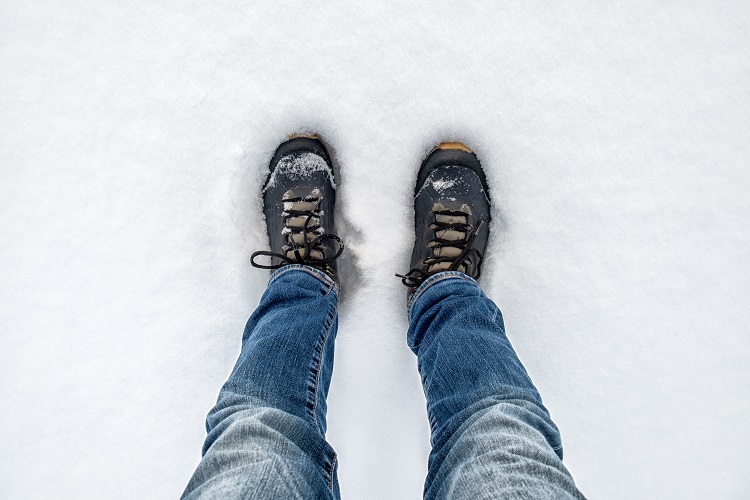Choosing The Right Shoes To Prevent Falling On Ice

Winters are beautiful, but you have to be extra cautious while venturing out and walking on the slippery ice layer. Slip and fall accidents during winters are common and can lead to serious injuries like broken bones, permanent back, and head injuries. Sadly, you can’t control the snowstorm or whether someone is keeping their sidewalks or parking lot ice-free or not. But still, you can take certain measures that can prevent your fall on the slippery ice surface.
In this article, we’ll discuss three ways to help you walk safely on the ice layer that generally forms on driveways, sidewalks, stairs, or parking lots.
If you are venturing out on the frozen lake, then your first and foremost question should be how thick should ice be to walk on? Experts suggest for walking safely, the ice layer should be at least 4 inches thick.
Here are some tips that might help to safely walk during the winter season:
1. Right Shoes To Increase Traction
Your shoes can make you prone to slipping or can save you from falling. Any icy surface lacks friction between your foot and the surface. High heels are a complete no when it comes to walking on ice. In heels, only a tiny portion of the shoes comes in contact with the ground that doesn’t help to get the required traction for walking on a slippery surface.
Boots with smooth soles are also not advisable as they can easily slide on the ice. However, boots with textured soles help to get some additional traction on the surface.
If your work requires you to spend a lot of time outside on the streets, you can go with spikes for shoes to walk on ice.
Slip-on cleats and spikes for shoes to walk on ice are a great choice to increase traction. You can just slide the cleats over the shoes you’re already wearing, and remove them when you’re safely inside.
2. Traction Agents
With shoe spikes, the problem is that you have to put them on and take them off every time you’re going out. Moreover, spikes on shoes work well on soft ice layers but skid on a hard icy surface. For immediate traction, you can also choose traction agents like Walk on Ice.
Walk on Ice is 100% natural and provides increased traction for walking on ice. You can also use it on your car tires if your car gets stuck in snow or not climbing on your inclined driveway.
3. Walk Slowly And Steadily
While walking on the ice take small steps and keep your position upright. Don’t take big strides by sliding your feet forward and backward. Since there is an absence of friction on the surface, sliding your leg on the surface can make you slip. Keep your hands free to break the fall in case if it happens. Spread your hands to your sides to maintain balance like a penguin.
Beyond Shoes: How Thick Does Ice Have To Be To Walk On?
You’ve already seen how the right footwear can save you from a nasty fall, but here’s something just as important: before you even think about walking on a frozen lake or pond, ask yourself—how thick does ice have to be to walk on safely? The general rule of thumb is at least 4 inches for a single person, but that number changes depending on the activity. If you’re in a group, you’ll need a thicker sheet, and if you’re driving something heavier like a snowmobile, the requirement goes even higher.
The problem is, ice thickness can vary even across the same water body. One patch might hold your weight, while a few steps over could spell disaster. Always check local ice reports, drill test holes if possible, and never assume that a snow-covered surface is safe just because it looks solid. Footwear helps with slips—but it won’t save you if the ice breaks underneath.
Get ready for winter with Walk On Ice instant traction on snow and ice
Outdoor Stair Treads For Ice: A Must For Winter Safety
Driveways and sidewalks aren’t the only danger zones in winter—stairs can be even riskier. Installing outdoor stair treads for ice is one of the simplest, most effective ways to reduce slips. These are rubber, plastic, or metal strips that add grip to each step. Some even come in heated versions, melting snow and ice before it can build up.
The best part? They’re reusable. You can keep them in place all season and avoid the daily struggle of shoveling, salting, or sprinkling sand that only works temporarily. For households with kids or elderly family members, stair treads act like a permanent insurance policy against sudden falls. They’re especially helpful on those early mornings when steps are coated with black ice you can’t see until you’re already mid-step.
What To Put On Wooden Stairs To Prevent Slipping
How To Make Wooden Stairs Less Slippery This Winter?If you’ve got a deck or porch, you already know how treacherous wooden stairs become when wet, snowy, or icy. So, what to put on wooden stairs to prevent slipping? You have a few choices.
- Non-slip adhesive strips: Affordable and easy to apply, these add grit to wooden steps without ruining their look.
- Rubber mats or runners: Great for high-traffic areas, though they can trap moisture if not lifted and cleaned regularly.
- Traction agents: Instead of harsh salts that damage wood fibers, a natural traction agent like Walk On Ice works well here. Sprinkle it directly on your steps for an instant grip that doesn’t harm the wood, your pets, or your plants.
If you’ve ever watched your dog or cat cautiously creep down slippery stairs, you’ll know pets need these protections just as much as people. Unlike traditional ice melts, a safe traction solution won’t burn paws or cause long-term damage to your outdoor wooden surfaces.
How To Walk On Ice Without Falling: Practical Tricks That Work
Even with the best boots, traction agents, or stair treads, you’ll still face moments when you’re stuck navigating a slick parking lot or icy path. That’s when it pays to know how to walk on ice without falling.
- Penguin walk: Keep your feet flat, take small shuffling steps, and angle your body slightly forward. Yes, it looks silly—but it works.
- Hands-free balance: Resist the urge to keep your hands in your pockets. Extend your arms slightly for balance, and be ready to catch yourself.
- Check surfaces before stepping: Tap lightly with your foot to test slipperiness, especially when approaching shiny or wet-looking patches.
- Stay slow and deliberate: Rushing is the easiest way to end up flat on your back. Take your time and plan each step like you’re crossing a balance beam.
Combine these walking techniques with smart tools like Walk On Ice, and you’ll have a multi-layered defense against both slips and surprises.
Conclusion: Safer Steps, Safer Winters
Preventing winter accidents isn’t about relying on a single method—it’s about layering protections. The right shoes and cleats keep your feet grounded, but understanding how thick does ice have to be to walk on ensures you don’t risk stepping onto unsafe ice in the first place. Adding outdoor stair treads for ice and knowing what to put on wooden stairs to prevent slipping makes your home safer for everyone, from kids to pets. And finally, practicing how to walk on ice without falling ties it all together, giving you confidence even when conditions are unpredictable.
So, while you can’t control the weather, you can control how prepared you are. By combining smart products like Walk On Ice with tried-and-true safety techniques, you transform icy winters from a hazard into a season you can enjoy—without fear of slips, slides, or falls.
Other Ice Melt Products
Safe Paw
The Original and #1 Selling Pet and Child Safe Ice Melt for over 20 years. Guaranteed environmentally safe – will not harm waterways and sensitive wetlands. All products are made in the USA.

Safe Thaw
Imagine an ice melt you can put down and never worry about. It won’t harm pets, kids, and your property. That’s Safe Thaw. Unlike anything else on the market, Safe Thaw can change how winter affects our planet.



